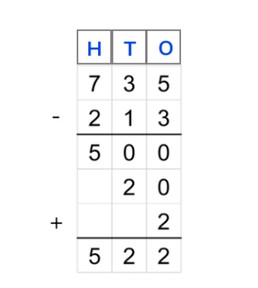
Partial differences subtraction to 1,000 without regrouping
Students learn partial differences to 1,000 with regrouping.



8,000 schools use Gynzy
92,000 teachers use Gynzy
1,600,000 students use Gynzy
General
Students learn partial differences to 1,000 without regrouping.
Standards
-2.NBT.B.7 / 3.NBT.A.2
Learning objective
Students will be able to subtract using the partial differences method to 1,000 without regrouping the tens and hundreds numbers.
Introduction
Ask the students what the largest number is that they can make with the numbers that are on the interactive whiteboard.
Instruction
Explain that for partial differences you put the numbers one under another. Then you can subtract them by working from left to right. So you start by calculating the hundreds values. You subtract these from each other. Then you subtract the tens numbers from each other, and then the ones values. You put all these answers in the diagram and you state what the intermediate problems are. If you add up the numbers in the diagram, you find the final answer. You put this final answer at the bottom of the diagram. Next, there is a problem in a diagram for which different lines are marked in yellow. As the students if they know which intermediate problem belongs in each of the colored rows. This is how you can check whether students know what steps they must take in solving such a problem. After this, you show a diagram for which the intermediate steps must be filled in. Have the students write these numbers down and hold them up so that you can check them. Then remove the cover to show what the answer is. Next, practice more partial differences with two problems, of which one has the diagram already filled in and the other must still be filled in.
Check whether the students can calculate partial differences using the following questions/exercise:
- Why is it useful to be able to calculate partial differences?
- What do the letters H T O mean?
- Where do you always start when you solve a partial difference?
- Solve these problems as partial differences: 567 - 36 and 484 - 362
Quiz
The students are given ten questions to practice with partial differences. They first practice with partial differences by stating what the intermediate steps are. Then they solve a few problems with partial differences. These problems consist of two or three numbers that the students must subtract from each other.
Closing
You discuss again with the students that it is important to be able to solve partial differences to 1,000, because that is how you can solve problems in steps. Check if the students know that for partial differences they must subtract from left to right. Show two children on the interactive whiteboard that are saying something about the table that has been filled in. Ask the students which child is correct and also ask why. Then you show the other pairs and ask who is correct. Also ask why the other is not correct and ask the students what they think their mistake is.
Teaching tips
For students that have difficulty with partial differences, you can repeat the meaning of H T O and how you arrange the numbers in an HTO- chart. Write the intermediate problems. You may also mark the hundreds numbers, tens numbers, and ones numbers, so that it is obvious which numbers you add together.
The online teaching platform for interactive whiteboards and displays in schools
Save time building lessons
Manage the classroom more efficiently
Increase student engagement
Discover more!
About Gynzy
Gynzy is an online teaching platform for interactive whiteboards and displays in schools.
With a focus on elementary education, Gynzy’s Whiteboard, digital tools, and activities make it easy for teachers to save time building lessons, increase student engagement, and make classroom management more efficient.



